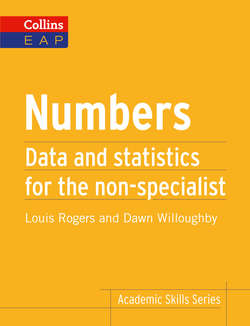Читать книгу Numbers: B2+ - Dawn Willoughby - Страница 10
What is statistics?
ОглавлениеEvery day in our lives, we hear and read about many different types of information in the form of data. Data can tell us interesting and important details about the world around us but it can be challenging to understand the facts and figures.
Statistics is a mathematical science that helps us to make sense of data that has been counted, measured, asked about or observed. It involves four main activities:
Glossary
method A method is a particular way of doing something.
technique A technique is a particular method of doing an activity, usually a method that involves practical skills.
Collecting data – first of all, we decide what type of data we are interested in, which method we shall use to collect the data, and where we would like to collect it from.
Organizing data – we use a range of different techniques to summarize the data we have collected so that we can see interesting features or patterns in the information.
Interpreting data – we use the results of calculations to help us make comparisons about different sets of data, to answer questions and make decisions about the world around us.
Glossary
feature A feature of something is an interesting or important part or characteristic of it.
Presenting data – when we have found out interesting facts about our data, then we will need to display and present the information to other people so that they can understand our conclusions.
Exercise 5
Choose a newspaper or news-related website and look for reports that use statistics to help explain the main points of the article. Think about these questions:
How was the data collected?
What type of organization is using the statistics?
What interesting features or patterns were found in the data?
How is the data presented?
Statistics is important in many different subject areas. The following diagram lists some examples of the type of data that might be collected and used:
